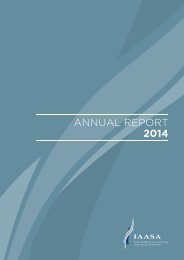Annual_Report2014
Create successful ePaper yourself
Turn your PDF publications into a flip-book with our unique Google optimized e-Paper software.
<strong>Annual</strong> Report 2014<br />
Irish Auditing & Accounting Supervisory Authority<br />
18<br />
Findings<br />
The issuer is a private equity fund structured as a<br />
company. The company has a finite life of 10 years<br />
which may, at the discretion of the shareholders,<br />
be extended to 15 years. There are three separate<br />
classes of shares in issue. The issuer classified and<br />
presented those shares as liabilities (and not as<br />
equity) in its statement of financial position.<br />
The three separate classes of shares in issue have<br />
identical rights and entitlements in all respects<br />
except the minimum subscription amount and<br />
management fee structure.<br />
After the initial 10 years, the power to extend or<br />
terminate the company and require the net assets<br />
to be distributed rests with the shareholders<br />
and not with the company; the shareholders had<br />
effectively the right to put the shares back to the<br />
company on liquidation.<br />
IAASA assessed whether some or all of the issuer’s<br />
shares met the requirements of paragraph 16C of<br />
IAS 32. Paragraph 16C requires that an instrument<br />
which imposes an obligation on an entity to<br />
deliver a pro-rata share of the net assets only<br />
on liquidation should classify its shares as equity<br />
instruments if it has all of the following features:<br />
a) entitles the holder to a pro-rata share of the<br />
net assets in the event of liquidation;<br />
b) the instrument is subordinate to all other<br />
classes of instruments; and<br />
c) all instruments in the class that is subordinate<br />
to all other classes must have an identical<br />
contractual obligation for the issuing entity<br />
to deliver a pro-rata share of its net assets on<br />
liquidation.<br />
IAASA concluded that, in this case, there was<br />
no apparent instance of non-compliance by the<br />
issuer by virtue of the performance fee element<br />
attaching to some shares, though a nominal<br />
management/performance fee might have lead<br />
to a different classification. IAASA obtained<br />
undertakings from the issuer to provide additional<br />
disclosures regarding the different share classes in<br />
future financial statements.<br />
IAASA noted that paragraph 16C of IAS 32 does<br />
not specify that different management fees/<br />
fee structure violates the identical contractual<br />
obligation requirement. Paragraph 16A(c) of IAS<br />
32, which is similar to paragraph 16C of IAS 32,<br />
gives examples of identical features which did<br />
not include fees as a distinguishing feature that<br />
might violate the identical features/contractual<br />
obligation requirement.<br />
Given the widespread implications for European<br />
funds of this decision by IAASA, the matter was<br />
discussed directly with the IASB and ESMA.<br />
Nonetheless, issuers should carefully consider<br />
whether the rights of all share classes merit or<br />
continue to merit a classification as equity or<br />
liability in accordance with paragraph 16C of IAS<br />
32. For an instrument to be classified as equity,<br />
holders must, amongst other matters, be entitled<br />
to a pro-rata share of net assets on liquidation.<br />
Issuers should provide a clear disclosure of the<br />
nature of the rights of different share classes<br />
including management/ performance fees<br />
payable by each share class and how, if any, the<br />
management/performance fee structure alters<br />
holders’ entitlements to a pro-rata share of the net<br />
assets on liquidation.



